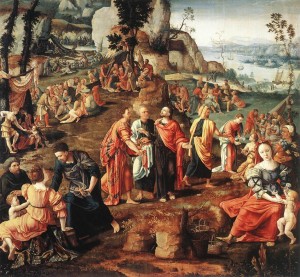John 6:24-35
This text is used for the Lectionary Year B on August 2, 2015.

In 6:24-35 an encounter occurs between Jesus and a Judean crowd, and it revolves around Jesus’ previous feeding of the 5,000 (6:1-15). One characteristic of this encounter is the use of questions. The Gospel of John is filled with probing questions directed towards Jesus. The Judean crowd and their questions are perfect examples of those seeking to know more about Jesus. Note the various questions put to Jesus by the crowd in these verses: (1) “Rabbi, when did you come here?” (v. 25); (2) “What must we do to perform works of God?” (v. 28); (3) “What sign are you going to give us then, so that we may see it and believe you?” (v. 30a); and (4) “What work are you performing?” (v. 30b).



